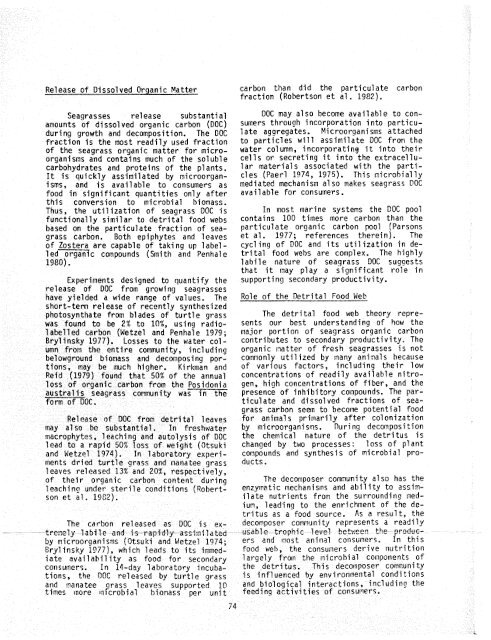The Ecology of the Seagrasses of South Florida - USGS National ...
The Ecology of the Seagrasses of South Florida - USGS National ...
The Ecology of the Seagrasses of South Florida - USGS National ...
You also want an ePaper? Increase the reach of your titles
YUMPU automatically turns print PDFs into web optimized ePapers that Google loves.
Re1 ease <strong>of</strong> Dissolved Organic Matter<br />
carbon than did <strong>the</strong> particulate carbon<br />
fraction (Robertson et a1 . 1982).<br />
<strong>Seagrasses</strong> re1 ease subs tanti a1 DOC may a1 so become available to conamounts<br />
<strong>of</strong> dissolved organic carbon (DOC) sumers through incorporation into particuduring<br />
growth and decomposition. <strong>The</strong> DOC late agaregates* Microorganisms attached<br />
fraction is <strong>the</strong> most readily used fraction to particles wilt assimilate DOC from <strong>the</strong><br />
<strong>of</strong> <strong>the</strong> seagrass organic matter for micro- water column, incorporating it into <strong>the</strong>ir<br />
organisms and contains much <strong>of</strong> <strong>the</strong> so1 uhf e cells or secreting it into <strong>the</strong> extracellucarbohydrates<br />
and proteins <strong>of</strong> <strong>the</strong> plants. lar materials associated with <strong>the</strong> parti-<br />
X t is quickly assimilated by microorgan- cles (Paerl 1974, 1975). This rnicrohial ly<br />
ism, and is available to consumers as mediated mechanism also makes seagrass DOC<br />
food In sfgnl ficant quanti tles only after available for consumers.<br />
this conversion to microbial biomass.<br />
Thus, <strong>the</strong> utilization <strong>of</strong> seagrass DOC is In most marine systems <strong>the</strong> DOC pool<br />
functionally similar to detrital food webs contains 100 times more carbon than <strong>the</strong><br />
based on <strong>the</strong> particulate fraction <strong>of</strong> sea- particulate organic carbon pool (Parsons<br />
grass carbon. Both epiphytes and leaves et al. 1977; references <strong>the</strong>rein). <strong>The</strong><br />
<strong>of</strong> Zostera are capable <strong>of</strong> taking up label- cycl ing <strong>of</strong> DOC and its utilization in deledTg8c<br />
compounds (Smith and Penhale trital food webs are complex. <strong>The</strong> highly<br />
19130). labile nature <strong>of</strong> seagrass DOC sugaests<br />
that it may play a significant role in<br />
Experlrnents designed to quantify <strong>the</strong> supporting secondary productivi ty.<br />
release <strong>of</strong> DOC From growing seagrasses<br />
have ylelded a wide range <strong>of</strong> values, <strong>The</strong> Role <strong>of</strong> <strong>the</strong> Oetrital Food Wet?<br />
short-tern re1 ease <strong>of</strong> recently syn<strong>the</strong>sized<br />
photosyntkatc from blades <strong>of</strong> turtle grass <strong>The</strong> detrital food web <strong>the</strong>ory reprewas<br />
found to be 2% to la%, usfng radio- sents our best understanding <strong>of</strong> how <strong>the</strong><br />
labelled carbon (Wetzel and Penhaf e 1979; unajor portion <strong>of</strong> seagrass organic carbon<br />
Bryl insky 1977). Losses to <strong>the</strong> water col - contri hutes to secondary productivity. <strong>The</strong><br />
umn frat!! <strong>the</strong> enttre community, including organic flatter <strong>of</strong> fresh seagrasses is not<br />
belawground bi onass and decomposing par- cornnonly util ized by many animals hocatrse<br />
ltons, may &e much higher. Kirkman and <strong>of</strong> various factors, including <strong>the</strong>ir low<br />
Reid (1979) found that 50% <strong>of</strong> <strong>the</strong> annual concentrations <strong>of</strong> readily available nitroloss<br />
af organic carbon from <strong>the</strong> Posidon& gen, high concentrations <strong>of</strong> fiber, and <strong>the</strong><br />
-<br />
&@st- seagrass community w a r t h e presence <strong>of</strong> inhibitory compounds. <strong>The</strong> par-<br />
form <strong>of</strong>: DOC,<br />
ticulate and dissalved fractions <strong>of</strong> seagrass<br />
carbon scan to become potential food<br />
Relcarse <strong>of</strong> DOC from detri tar leaves for animals primarily after colonization<br />
may a1 so be substantial. In freshwater by fnicroorganisfils. During decomposition<br />
macmphytes, leachlng and autolysis <strong>of</strong> DOC <strong>the</strong> chemical nature <strong>of</strong> <strong>the</strong> detritus is<br />
lcad ts a rapid 50% loss <strong>of</strong> weight (Otsuki changed by two processes: loss <strong>of</strong> plant<br />
and Wetzel 1974). fn laboratory experi- conpounds and syn<strong>the</strong>sis <strong>of</strong> microbial prornents<br />
dried turtle grass and manatee grass ducts.<br />
1 eaves released 13% and 20X, respectively,<br />
<strong>of</strong>' <strong>the</strong>tr organfc carbon content during <strong>The</strong> deconpaser ciomuni ty also has <strong>the</strong><br />
teaching under sterile candi tions (Robert- enzyrratic rnechanis~vs and abil f ty to assimson<br />
et at. 3.982).<br />
ilate nutrients from <strong>the</strong> surrounding medium,<br />
leading to <strong>the</strong> enrichment <strong>of</strong> <strong>the</strong> detritus<br />
as a food source. As a result, <strong>the</strong><br />
<strong>The</strong> carbon released as DOC is ex- decomposer comm?rnity represents a readily<br />
tt*c:?,cly 12b.fle and ir; rapfdly assfjnj jdted t,'sdBle tropkic level Bett!cer, <strong>the</strong> producby<br />
microorganl"sms (Otsuki and It!et.rel 1974; ers and [nost animal consumers. In this<br />
Gry'iinsky 19771, which leads to its immed- food weh, <strong>the</strong> consumers derive nutrition<br />
iate availabil ity aas food for second at*^ largely fran Ltte nicrohial coa~ponents <strong>of</strong><br />
eonsumerr. In 14-day lahoratot-y incuha.. <strong>the</strong> detritus. This decornposer co~~uni ty<br />
tions, <strong>the</strong> DOC released by turtle grass 1s inFluenced by crnviront~ental conditions<br />
and ~anatee qrass leaves supported 10 and biological interactions, including <strong>the</strong><br />
Limes rnore ~nkrobial biomass per unj t feed~ng activities <strong>of</strong> cansur?ers.<br />
74

















